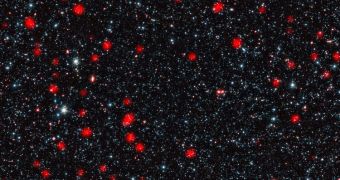According to the conclusions of a new scientific study conducted by an international collaboration of astronomers, it would appear that the emergence of the first supermassive black holes was responsible for curbing intense stellar formation processes in the very first galaxies ever to develop.
The enormous behemoths were generated by the collapse of massive stars, which went supernova before their cores imploded to form the structures. Over time, the objects grew even more, accreting more and more mass, and increasing their sizes.
What is very interesting to note there is that galaxies in the very early Universe displayed intense, powerful bursts of stellar formation. What this means is that thousands of stars were produced in numerous stellar nurseries throughout each of these galaxies.
But observations conducted with the world's most advanced telescopes revealed a very interesting scenario, in which these stellar formation bursts were shut down early on, preventing galaxies from growing further, and setting them on a degenerative path.
Without new stars, these structures turn from blue to red, as the average colors of their stars changes throughout their lifespans. This is why the most distant galaxies today are also the reddest, when seen in optical wavelengths.
For the new study, astronomers used the Atacama Pathfinder Experiment (APEX) on the Chajnantor plateau, in the Chilean Andes. The instrument belongs to the Atacama Large Millimeter/submillimeter Array (ALMA), an installation that will be the largest radio telescope in the world, when completed.
“This is the first time that we've been able to show this clear link between the most energetic starbursting galaxies in the early Universe, and the most massive galaxies in the present day,” astronomer Ryan Hickox explains.
The expert, who was the lead scientist on the new investigation, holds joint appointments at the Durham University (UK) and the Dartmouth College (US).
He explains that additional data for the mission came from the European Southern Observatory's (ESO) Very Large Telescope (VLT), the NASA Spitzer Space Telescope, and other observatories.
“By measuring the masses of the dark matter halos around the galaxies, and using computer simulations to study how these halos grow over time, the astronomers found that these distant starburst galaxies from the early cosmos eventually become giant elliptical galaxies,” an ESO press release reports.

 14 DAY TRIAL //
14 DAY TRIAL //